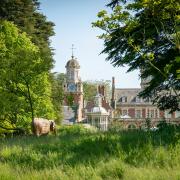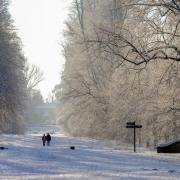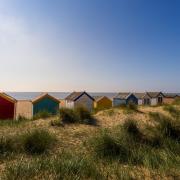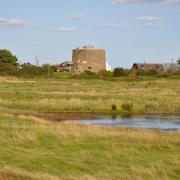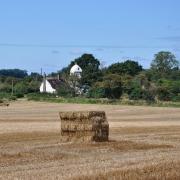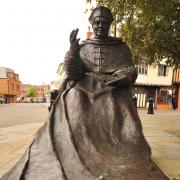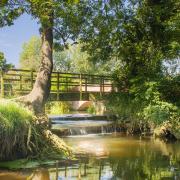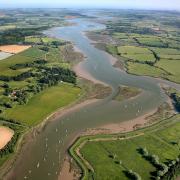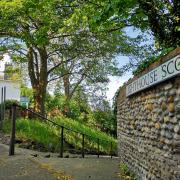Lindsay Want views Suffolk from the Essex Way on a Stour estuary circular walk starting at Wrabness

There's nothing like a journey to make you focus on home. Take the train towards Harwich and as you cross the Stour, leaving Constable Country behind you at Cattawade, Tendring does its utmost to lure you with its grand towers at Mistley, and its chilling tales of Witchfinder General Matthew Hopkins.
The old malting quaysides are undeniably charming, with bobbing boats and swans a-swimming. But sorry, Essex, it's all eyes north across the widening river to trace Suffolk's Seafield Bay, seek out Stutton Mill and spot the tower of Holbrook's Royal Hospital School piercing the vast stretch of wrap-around sky.
Strange how, when we're at a distance from home, the need to identify every point, pinnacle and patchwork of a familiar landscape can be so compelling. Seeing our county from different viewpoints, especially along the Essex Way, somehow makes it even more fascinating.
Alight at Wrabness and from the lofty heights of the station's community garden, the glimpse you get of Suffolk's true colours across the estuary changes with the seasons. In spring, the Holbrook 'hills' trace a dark, purple streak across the horizon.

Come summer, Suffolk emeralds merge with Essex greens, until a walk westwards reveals the great blue divide of the Stour, as the land falls away along Church Road. Larks in song climb the sky, and far down river, the Port of Felixstowe's great cranes stretch their necks above the estuary.
In the middle distance, between Felixstowe docks and the sloping brassica fields of Wrabness, something glints gold in the sunlight. It's an unexpected distant discovery, nestling by the trees, defying identification with just the naked eye.
Yet even binoculars don't shed much light. Camouflaged in layers of bottle green, there are flecks of red and streaks of white - not the plumage of a bird, but a building with window arches peering like big eyes over its wall, capped off with a dull-gold topknot. A chapel perhaps?
Meanwhile, All Saints on Church Street is Norman in origin and built out of Septaria from the shoreline. It sits tower-less at the top of the valley slope. Outside stands a bell-cage, the apparently 'temporary' fix constructed when the church tower collapsed in the 17th century. Inside, roughly sawn-off hammerbeams suggest the speed with which its guardian angels were forced to fly the nest a good century earlier.

Onwards and downwards, along the Essex Way towards the mudflats by Stone Point. As Suffolk comes firmly into view, you can't help making connections. Didn't Shotley's church tower far to the east also have an unfortunate totter? And what about East Bergholt's bell-cage further upriver? Cardinal Wolsey's sad demise left the church with bells but no tower, and Ipswich with an ambitious Tudor college but no benefactor.
Four centuries later, one Herbert Tudor Buckland mapped out the fine Royal Hospital School on the Suffolk banks of the Stour at Holbrook. Viewed across Wrabness' sea-lavender shelves and meandering Stourland creeks, it betrays little of its real redbrick splendour and save for its needle-like clock tower, it looks white and low-lying, like a moored vessel with a towering mast. Close up, through binoculars, you'd almost think you were gazing across the Thames at Greenwich.
Back on the Essex Way, the golden glint is back, twinkling through the trees at the top of the meadow slope. Viewed end on, the structure looks more chapel-like than ever and dog-walking pilgrims seem to be following a path. Curious indeed.
From a distance, where you can't see the common terns, oystercatchers or seasonal travellers, Johnny All Alone Creek by Erwarton Ness across the river appears bleak and silent. From here, it's easy to imagine it as the historic haunt of smugglers in the days when folk at Copperas Bay on the Essex side were busy mining iron sulphate for indigo production and the dyeing industry.

Beyond Stour Wood by the railway line, the riverscape sky is wide and the world is bright. This time, the glint of gold is Suffolk-side. Just round from the Harkstead Hermitage, a rich yellow sliver of sand catches the light and the mind drifts to tales of ancient boats, visions of the great 'lighters' journeying past Mistley's iconic towers and Flatford's immortalised mill, to the Sudbury quaysides by Gainsborough's beloved water-meadows.
Just cross the meadow now, the distant 'chapel' roof has exchanged its gold for olive greens. At Black Boy Lane there's at last a chance to come close and pay homage to this curious companion which has popped up again and again along the way.
Grayson Perry's A House for Essex - both an artwork and a setting for art - might be as quackers as the shelducks on the River Stour mudflats, with its rich shiny tiles and enigmatic sculptures, but people travel from all over and even take part in a ballot to stay here. It makes statements, interprets, raises questions, lifts spirits, celebrates local colour and explores identity. Ultimately it makes us focus on home.
What would 'A House for Suffolk' look like? That's something for the train ride back across the Stour.
Ordnance Survey maps are available from all good booksellers and outdoor stores or visit our online shop www.ordnancesurvey.co.uk/al

The route
1) Start at Wrabness railway station (CO11 2TN). Leaving station car park, turn right onto Station Road, past community garden. Turn right over railway bridge into Church Road which curves left.
2) Explore All Saints Church then retrace steps, taking signed footpath left (Essex Way) onto Stone Lane, downhill past caravan park (left) towards river.
3) At bottom of hill turn right onto footpath just before wooden buildings. At Shore Farm, path climbs onto river bank ridge briefly with open views across Stour.

4) Time for a detour or only want a short walk? Take footpath right uphill to Grayson Perry's 'A House for Essex' (9), then continue straight ahead along Black Boy Lane to Station Road/ Wrabness station.
Continue straight ahead, going through East Grove via two tall kissing gates onto field edge path by river edge (left). Continue straight ahead. As riverside path becomes more wooded below Stour Wood by Copperas Bay ( RSPB bird hide near here), keep left following Essex Way signs.
5) Follow path (Essex Way) right, uphill with Copperas Wood Nature Reserve fenced off to the left.
6) Immediately after railway bridge, turn sharp right along permissive path, parallel to railway track, to enter Stour Wood/ Stour Estuary Nature Reserve. Path goes left, then - ignoring signs for car park - head right to cross the woodland to a gate / kissing gate by a bungalow.

7) Go through kissing gate, then right onto track briefly. Turn left at T-junction of paths to edge woodland and enter field through another kissing gate. Path leads across to a track.
8) Go right, over railway bridge, then sharp left. Path edges railway line (left) and field (right) with views to Stour, to emerge by houses onto Black Boy Lane. Turn right to head towards Grayson Perry's 'A House for Essex'.
9) There are good, close views of 'A House for Essex' from the lane. Follow footpath at right of the property to view it from the other side. Retrace steps and continue uphill, all the way along Black Boy Lane to Station Road / Wrabness station /community shop.
A house for Suffolk?
A House for Essex was commissioned from Chelmsford-born artist Grayson Perry and FAT Architecture by Living Architecture, an organisation aiming to shift perceptions of modern architecture. (livingarchitecture.co.uk)
What's your vision for 'A House for Suffolk'? Drop us a line with your ideas - we'd love to hear from you. suffolkmagazine@archant.co.uk
Distance/time: 4.5 miles/7.2 km, 2.5 hours
Start: Wrabness railway station (CO11 2TN).
Getting there/back: nationalrail.co.uk/suffolkonboard.com
Parking: Wrabness Station (or in front of All Saints church)
Access: Riverside, field-edge, woodland footpaths, some tarmac roads. Kissing gates, steps.
Big map: OS Explorer 184 (Essex)/197 (Suffolk)
Ts & Ps: Community shop by Wrabness station, open daily




